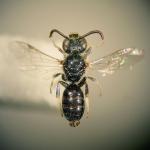Restricted to southern England; from Devon to Kent, north to Oxfordshire and Norfolk. Also found in the Channel Islands (Jersey and Guernsey).
Abroad, a Western Palaearctic species, from Britain, France, south-west Germany and Morocco eastwards to Bulgaria, Montenegro and Asia Minor. Rather sporadic in the west of its range (S P M Roberts, pers. comm.).
Given Rare (RDB3) status in both Shirt (1987) and Falk (1991).
Mostly found on the light soils of sandy heathland and coastal sands, but also occasionally on calcareous grassland.
The female flies from mid April to mid October and the male from mid July to early October.
The nesting biology is not known but it is a mining bee, possibly eusocial. The nest may be dug in sparsely vegetated, sandy banks facing south, where it is sometimes captured (pers. obs.).
It is known to visit ragwort, hawk’s-beard, and viper’s bugloss; some of these may represent pollen sources.
No data available.
2019


